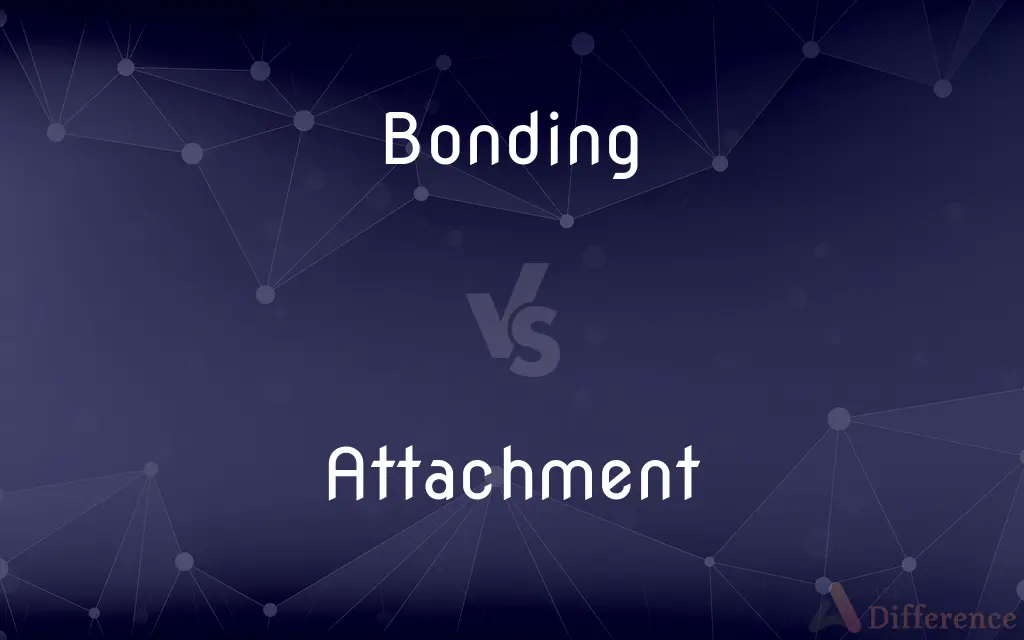Bonding vs. Attachment — What's the Difference?
By Urooj Arif & Fiza Rafique — Updated on April 1, 2024
Bonding is the initial emotional connection formed by parents with their newborn, while attachment refers to the deep, long-term emotional relationship that develops between a child and their caregiver.

Difference Between Bonding and Attachment
Table of Contents
ADVERTISEMENT
Key Differences
Bonding typically occurs shortly after birth, with parents often experiencing an intense affection and a desire to protect and care for their newborn. This process is crucial for the child's emotional development and can influence the parent's feelings towards the child. On the other hand, attachment develops over time through consistent interactions and responses to the child's needs, leading to a secure or insecure attachment style, which affects the child's social and emotional development.
Bonding is seen as a foundation for the attachment process, with early positive bonding experiences helping to foster a secure attachment relationship. However, bonding is just one of many factors that contribute to the quality of attachment. Attachment is influenced by ongoing care, the caregiver's sensitivity to the child's signals, and the emotional and physical environment.
While bonding is mainly discussed in the context of the parent-child relationship immediately after birth, attachment encompasses a wider range of relationships and interactions throughout the child's life. Attachment can form with any consistent caregiver and is critical for the child's emotional regulation, sense of security, and ability to form healthy relationships in the future.
The distinction between bonding and attachment highlights the complexity of early emotional development. Understanding the nuances between them is essential for parents and caregivers to provide the nurturing and responsive care that supports healthy emotional and psychological development in children.
Comparison Chart
Definition
The initial emotional connection formed by parents with their newborn.
The deep, long-term emotional relationship between a child and their caregiver.
ADVERTISEMENT
Timing
Occurs shortly after birth.
Develops over time through consistent interaction.
Focus
Initial affection and protection towards the newborn.
Quality of the ongoing relationship and its impact on development.
Theoretical Basis
Based on early interactions and physical closeness.
Rooted in attachment theory, emphasizing the response to the child’s needs.
Outcome
Influences parental feelings and care behaviors.
Affects the child’s social, emotional development, and future relationships.
Compare with Definitions
Bonding
Affects how parents interact with and care for their child.
Strong bonding can enhance parental sensitivity and responsiveness.
Attachment
Develops through consistent caregiving.
Secure attachment is built on reliable and responsive care.
Bonding
Sets the stage for developing a secure attachment.
Positive bonding experiences can lead to a secure attachment style.
Attachment
Helps the child develop coping strategies for stress and fear.
Attachment provides a safe base for emotional exploration and growth.
Bonding
Focuses on the parent's feelings towards the newborn.
Bonding involves the parent’s immediate affectionate response to the child.
Attachment
Concerned with the child’s perception of the caregiver's availability.
Attachment shapes the child’s emotional security and exploration.
Bonding
Critical for emotional development right after birth.
Skin-to-skin contact promotes bonding.
Attachment
Dependent on the caregiver's sensitivity and responsiveness.
Attentive caregiving fosters secure attachment.
Bonding
Emphasizes the importance of physical contact in the bonding process.
Holding and feeding the baby are key bonding activities.
Attachment
The act of attaching or the condition of being attached.
Bonding
The formation of a close human relationship, as between friends
"He says he has rediscovered the comforts of male bonding in a Washington men's group" (Marilyn Chase).
Attachment
Something, such as a tie, band, or fastener, that attaches one thing to another.
Bonding
The emotional and physical attachment occurring between a parent or parent figure, especially a mother, and offspring, that usually begins at birth and is the basis for further emotional affiliation.
Attachment
An emotional bond, as of affection or loyalty; fond regard.
Bonding
A dental technique in which a material such as plastic or porcelain is attached to the surface of a discolored or damaged tooth.
Attachment
A supplementary part; an accessory
Bought a vacuum cleaner with several attachments.
Bonding
The technique of using adhesives to attach orthodontic brackets or other appliances to the teeth.
Attachment
A supplementary document that is attached to a primary document
Stapled two attachments to the memorandum.
Bonding
Present participle of bond
Attachment
A file that is attached to an email.
Bonding
The act by which something is bonded or joined together.
Attachment
Legal seizure of property.
Bonding
A relationship between a parent and offspring that establishes the basis for an ongoing mutual attachment.
Attachment
The writ ordering such a seizure.
Bonding
(networking) A method of aggregating multiple network interfaces on a computer into a single logical interface
Attachment
The act or process of (physically or figuratively) attaching.
Bonding
An arrangement by which goods remain in the customs warehouses until the duties are paid.
Attachment
A strong bonding with or fondness for someone or something.
I have such an attachment towards my fiancé!
Bonding
The process of fastening firmly together.
Attachment
A dependence, especially a strong one.
Bonding
Fastening firmly together
Attachment
A device attached to a piece of equipment or a tool.
Bonding
A close personal relationship that forms between people (as between husband and wife or parent and child)
Attachment
The means by which something is physically attached.
Bonding
(dentistry) a technique for repairing a tooth; resinous material is applied to the surface of the tooth where it adheres to the tooth's enamel
Attachment
(computing) A file sent along with a message, usually an email.
Attachment
(legal) Taking a person's property to satisfy a court-ordered debt.
Attachment of earnings
Attachment
(meteorology) The act or process by which any (downward) leader connects to any available (upward) streamer in a lightning flash.
Attachment
The act attaching, or state of being attached; close adherence or affection; fidelity; regard; an passion of affection that binds a person; as, an attachment to a friend, or to a party.
Attachment
That by which one thing is attached to another; connection; as, to cut the attachments of a muscle.
The human mind . . . has exhausted its forces in the endeavor to rend the supernatural from its attachment to this history.
Attachment
Something attached; some adjunct attached to an instrument, machine, or other object; as, a sewing machine attachment (i. e., a device attached to a sewing machine to enable it to do special work, as tucking, etc.).
Attachment
A seizure or taking into custody by virtue of a legal process.
Attachment
A feeling of affection for a person or an institution
Attachment
A supplementary part or accessory
Attachment
A writ authorizing the seizure of property that may be needed for the payment of a judgment in a judicial proceeding
Attachment
A connection that fastens things together
Attachment
Faithful support for a religion or cause or political party
Attachment
The act of attaching or affixing something
Attachment
The act of fastening things together
Common Curiosities
What is the role of play in attachment?
Play is vital in attachment as it strengthens the bond between child and caregiver through positive interaction, communication, and mutual joy.
How can caregivers foster a secure attachment?
Caregivers can foster secure attachment by consistently responding to the child's needs in a sensitive and loving manner, providing comfort, and encouraging exploration.
Is it possible to form an attachment later in life?
While early childhood is critical for attachment formation, significant relationships developed later can also affect attachment styles and emotional regulation.
What is the difference between bonding and attachment?
Bonding is the initial emotional connection between parents and their newborn, while attachment is the ongoing, deep emotional bond that develops between a child and their caregiver.
Can attachment styles change over time?
Yes, with therapy, positive experiences, or changes in the caregiving environment, an individual's attachment style can become more secure even if it was insecure in childhood.
Are there cultural differences in bonding and attachment?
Yes, cultural practices influence bonding and attachment behaviors, though the fundamental need for secure relationships is universal.
Can bonding affect attachment?
Yes, early bonding experiences can influence the development of attachment by setting a positive foundation for the caregiver-child relationship.
How does the environment influence attachment?
The environment, including the home setting, societal conditions, and the wider community, impacts the quality of caregiving and, consequently, the attachment style.
What strategies can help repair attachment issues?
Strategies include therapy focused on developing trust and security, such as attachment-based therapy, and creating positive relational experiences.
Can a child form attachments with multiple caregivers?
Yes, children can develop attachments with multiple consistent caregivers, which can contribute to a richer social and emotional development.
How does secure attachment benefit a child?
Secure attachment provides a foundation for healthy emotional development, including better stress management, social skills, and relationships in the future.
What happens if bonding doesn't occur immediately after birth?
Immediate bonding is beneficial, but it's not the only determinant of a healthy attachment. Quality, consistent caregiving over time is more crucial for attachment.
What are some signs of a secure attachment?
Signs include seeking comfort from the caregiver when upset and using the caregiver as a secure base for exploration.
Share Your Discovery

Previous Comparison
Mosquito vs. Fleabite
Next Comparison
Alleviation vs. MitigationAuthor Spotlight
Written by
Urooj ArifUrooj is a skilled content writer at Ask Difference, known for her exceptional ability to simplify complex topics into engaging and informative content. With a passion for research and a flair for clear, concise writing, she consistently delivers articles that resonate with our diverse audience.
Co-written by
Fiza RafiqueFiza Rafique is a skilled content writer at AskDifference.com, where she meticulously refines and enhances written pieces. Drawing from her vast editorial expertise, Fiza ensures clarity, accuracy, and precision in every article. Passionate about language, she continually seeks to elevate the quality of content for readers worldwide.














































